
877-842-8733

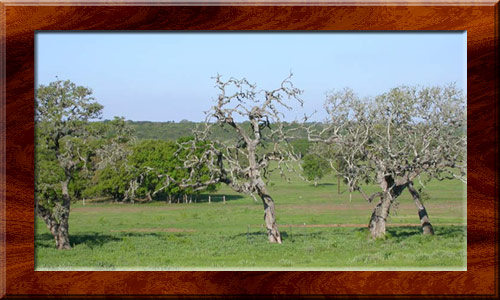
Oak Wilt Destruction near Dripping Springs, TX
Oak Wilt is Widespread
Oak Wilt is one of the most destructive tree diseases in the United States and is found in 25 states. In Central Texas, and especially the Hill Country, our vast forest of Live Oaks is being devastated, impacting 65 counties in Texas. Oak Wilt is caused by a fungus with the scientific name of Bretziella fagacearum (previously known as Ceratocystis fagacearum). This fungus infects our Oaks and colonizes the water conducting tissues. The reaction of the tree to this infection results in the blockage of these water conducting tissues; ultimately resulting in severe die-back or tree death.
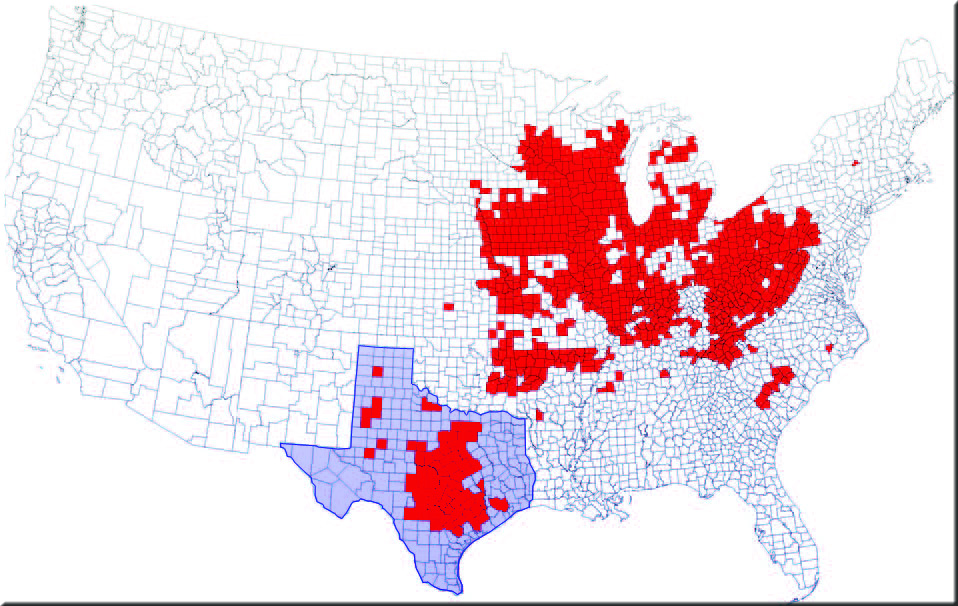
Oak Wilt Spreads Above and Below Ground
The disease spreads in two ways; via sap feeding insects (Nitidulid beetles) carrying spores on their bodies (overland transmission) and through interconnected roots among trees (root transmission). Other methods of transmission may occur but have not been scientifically proven.
Overland transmission of Oak Wilt begins with an infected red Oak (Shumard Oak, Spanish Oak, Blackjack Oak, Texas Red Oak, etc.). When a red Oak dies, one or more fungal spore mats may form under the bark. The mat grows and expands causing the bark to crack open. The spore mat emits an odor that attracts Nitidulid beetles. The beetles enter the spore mat to feed and spores stick to the insect. These beetles then travel to other trees to feed on the sap from a fresh wound. The Oak Wilt spores may then infect that tree, starting a new disease center. Experiments have shown that under their own power these insects can travel a mile or more and may appear on fresh wounds in 15 minutes or less.
Root transmission is largely a problem for Live Oaks. The root system of one Live Oak is highly interconnected to neighboring Live Oaks. The fungus travels through the roots from one Live Oak to the next. The disease can spread in this manner from an infected tree at a rate of 75 to 100 feet per year on average. Due to the high concentration of Live Oaks in Central Texas, root system transmission destroys large areas of Live Oak forest. Spore mats do not form on Live Oaks as they do on red Oaks. Contrary to popular belief, simply removing dead trees either by cutting them down or bulldozing them, does not eliminate the root transmission of the disease. Treatment of trees does not prevent root transmission either. The only way to prevent root transmission is to completely sever root connections between healthy and sick trees.
Identification of Oak Wilt
Confirmation that Oak Wilt is present in a particular location might be challenging. However, a Certified Arborist that specializes in Oak Wilt can usually make a diagnosis in a fairly short period of time. A professional will make sure that other factors such as chemical poisoning, drought, construction damage and lightning strikes are not misdiagnosed. There are four primary ways to identify Oak Wilt; foliar (leaf) symptoms, patterns of tree mortality, fungal mats and laboratory tests.
Foliar Symptoms
The prominent symptom most commonly associated with Oak Wilt is the distinctive browning out of the veins in Live Oak leaves. This pattern that often reminds people of "fish bones" is called veinal necrosis. The veins in the leaf become yellow or brown and the leaf soon falls off the tree. Even after drying out and turning completely brown, the symptomatic leaf retains the distinctive darker veins. Unfortunately, veinal necrosis does not occur in red Oaks. Trees in this family defoliate in a manner similar to autumn with the leaves turning brown from the edges in and then falling off. Defoliation of a red Oak at an odd time of the year should always be investigated. In addition to veinal necrosis in Live Oaks, there are other types of foliar symptoms including interveinal necrosis (the reverse of veinal necrosis) or veinal banding, tip burn (where the end of the leaf turns brown) and margin burn (where the entire edge of the leaf turns brown). Major defoliation (leaf loss) of a Live Oak other than during spring (when they normally replace their leaves) should be investigated.
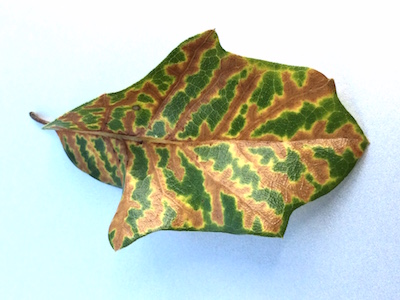
Veinal Necrosis (VN)
This example shows how the veinal necrosis can be finely detailed throughout the leaf.
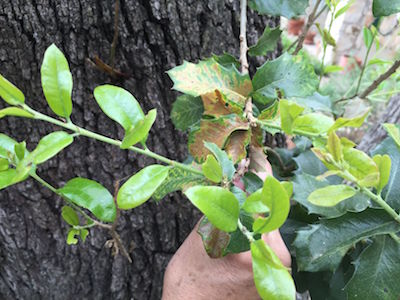
New Leaves and VN
Old leaves showing veinal necrosis coexist with new leaves (not showing symptoms yet) put on in the spring.

Classic VN
This is an example of how veinal necrosis is typically presented on a leaf.
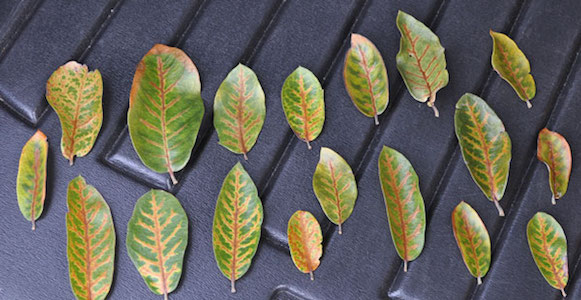
VN Collection
The tree these were collected from was generating a large number of symptomatic leaves.
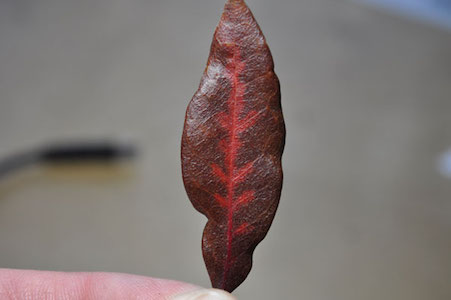
VN on a Red Leaf
Some Live Oaks turn a dark red color prior to dropping their leaves in the spring. Veinal necrosis on this leaf shows up bright red.
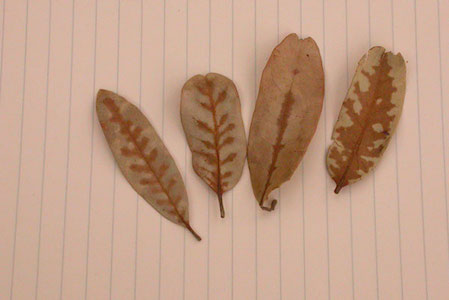
Brown VN
The veinal necrosis pattern is distinctive in old leaves.
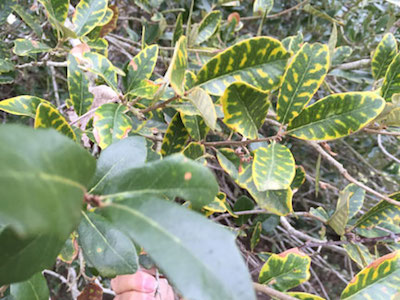
Veinal Banding (VB)
Veinal banding or inter-veinal necrosis is shown here. The yellowing of the area between the veins is not common but really helps to illustrate the symptom.

Classic VB
When veinal banding occurs, the veins remain a normal green color and the remainder of the leaf turns pale.
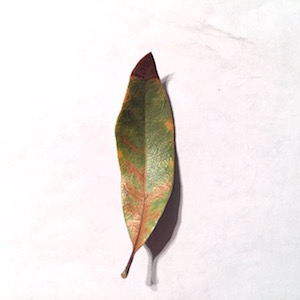
VN and VB
This leaf has a combination of both VN and VB.

Margin Burn
Margin burn is a symptom of Oak Wilt where the edge of the leaf turns brown. These leaves also have veinal necrosis.

Tip Burn
This symptom is similar to margin burn, but only the ends of the leaf turn brown.

Symptoms on Immature Leaves
New leaves on Live Oaks often do not show symptoms. But when they do, you can see hints of VN and margin burn.
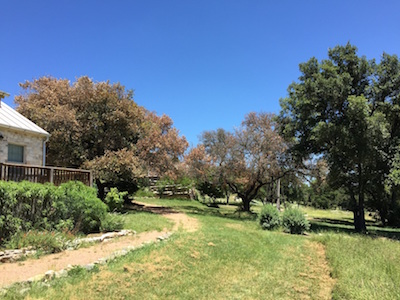
Flashing Live Oaks
Sometimes a Live Oak will die from Oak Wilt very quickly. These trees turned completely brown in a matter of days. Often this type of quick death does not produce any of the symptoms shown above.
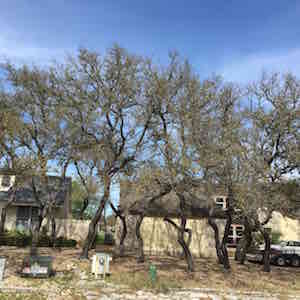
Thinning Live Oaks
The normal progression of the disease in Live Oaks is extreme thinning of the canopy like that shown here.
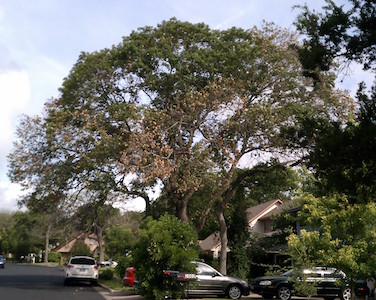
Texas Red Oak with Oak Wilt
Red Oaks like this one die quickly from Oak Wilt. This tree has major portions of the canopy browning out.
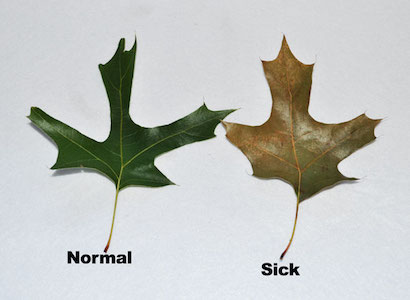
Bronzing Red Oak Leaves
One of the symptoms of Oak Wilt in red Oaks is an apparent bronzing of the leaves as shown here.
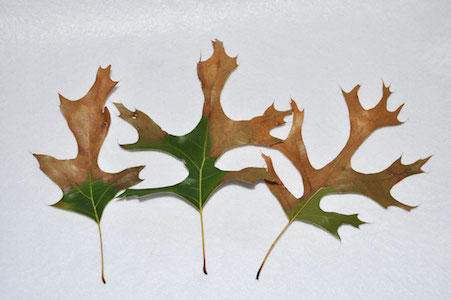
Tip Burn in Red Oak Leaves
Another common symptom of Oak Wilt in red Oaks is tip burn.
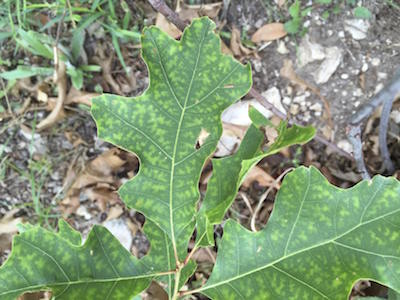
VB in Red Oak
Red Oaks do not typically show VB. However, this example was observed in Marble Falls.
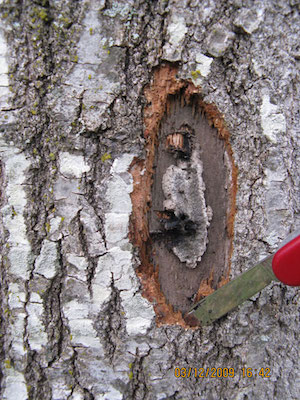
Fresh Fungal Mat on Texas Red Oak
Shown is a fresh Oak Wilt fungal mat on a red Oak. The insects that spread Oak Wilt are highly attracted to these spore mats.
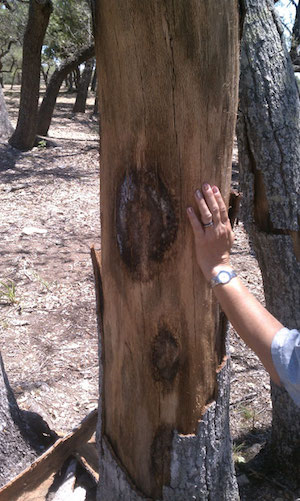
Fungal Mat Remnant
Shown is the remnant of an Oak Wilt fungal mat on a long dead red Oak. This spore mat is no longer an infection hazard because it has dried out.
Fungal Spore Mats
The presence of fungal mats (examples shown above) on red Oaks is most definitely a sign of Oak Wilt. However, mats do not form on Live Oaks and are not present on all infected red Oaks. The mats are commonly hidden from view under the bark and may not be visible. Many arborists have worked in the field for years without seeing a fungal mat.
Laboratory Testing
Oak Wilt can be confirmed by growing the fungus in the lab. Samples from trees suspected of having the disease are harvested and sent to the Texas Plant Disease Diagnostic Laboratory in College Station, TX. However, due to the delicate nature of the fungus it can be difficult to get a viable sample. The result is that there are a fair number of false negatives from the sampling process.
Disease Centers
A cluster of dead Live Oaks may indicate the presence of an Oak Wilt disease center. This is especially true if the cluster continues to expand in size over time. Generally, Oak Wilt disease centers have completely dead trees at the center ringed by sick and dying trees further out followed by normal looking trees.
Management and Control of Oak Wilt
Once a positive identification of the disease has been made, there are three possible methods of dealing with the disease; do nothing, sever the root system between infected trees and healthy trees, and injection of fungicide into trees. Our staff of experienced professionals can help you balance a combination of all three possibilities by explaining the economics and aesthetics involved. We can design a management program based on your budget, the forest environment on your property and the realities of Oak Wilt. Doing nothing may be an appropriate response in areas where there are a limited number of trees at risk or the value of those trees is minimal. Such a course of action might be taken where Oak Wilt has already claimed the high value trees in an area and the remaining specimens are in poor health or in a remote area. Root trenching is appropriate where there is sufficient space and lack of existing buried infrastructure to correctly and economically install a trench. Fungicide treatment is appropriate for high value trees that cannot be isolated by a trench. In general, injections work very well with pre-symptomatic trees and for smaller areas.
Prevention of Oak Wilt
Many new Oak Wilt disease centers are caused by human activity. We can all take steps to reduce the chance of starting a new Oak Wilt center. Here’s how:
1. Avoid pruning Oak trees between early February and late June.
2. If it is necessary to prune susceptible trees, or if trees are wounded, use a wound paint (pruning sealer) immediately. A new infection can be started quickly on a fresh wound (less than 15 minutes). Wounds are naturally sealed off by the tree after about a week. So painting old wounds is of no value. All fresh wounds, regardless of size or if the removed branch was alive or dead, should be painted.
3. Trench around active Oak Wilt centers to stop the spread of the fungus through common or grafted roots.
4. Watch trees in and around Oak Wilt centers for new infections. Take steps immediately to prevent additional spread.
5. Sanitize cutting equipment with a bleach solution (or Lysol® spray) before cutting on an Oak tree and before moving on to the next tree so as to avoid the possibility of cross contamination.
6. Avoid firewood infected with the Oak Wilt fungus, unless it has properly dried (12 months). Cover new firewood piles with clear plastic for one year. Make sure that the edges of the plastic are buried with soil to prevent insect migration out of the wood pile.
Oak Wilt is a serious problem. Call us at 877-842-8733 before you work on your trees or if you suspect that you have a problem.
